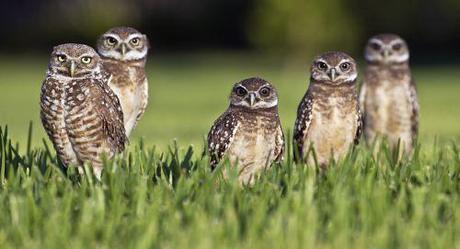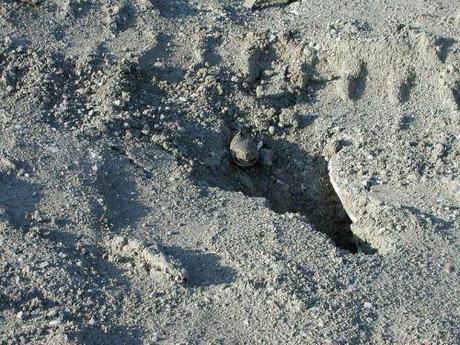Athene cunicularia

The Burrowing Owl (Athene cunicularia) is a tiny long-legged owl found throughout open landscapes of North and South America.
Measuring 7.5–11 in long and weighing 4.9-8.5 oz. with wing spans of 20-24 in., an average adult Burrowing Owl is slightly larger than an American Robin. The owls have prominent white eyebrows and a white “chin” patch which they expand and display during certain behaviors, such as a bobbing of the head when agitated.
Unlike most owls, Burrowing Owls are often active during the day, although they tend to avoid the midday heat.
They nest and roost in underground burrows, such as those excavated by prairie dogs, hence the name Burrowing Owl. If burrows are unavailable and the soil is not hard or rocky, the owls may excavate their own. Burrowing Owls will also nest near roads, farms, homes, and in shallow, underground, man-made structures that have easy access to the surface, such as irrigation canals.

The nesting season begins in late March or April in North America. Burrowing Owls usually only have one mate but occasionally a male will have two mates. During the nesting season, Burrowing Owls will collect a wide variety of materials to line their nest, some of which are left around the entrance to the burrow. The most common material is mammal dung, usually from cattle. At one time it was thought that the dung helped to mask the scent of the juvenile owls, but researchers now believe the dung helps to control the microclimate inside the burrow and to attract insects, which the owls may eat.
The female will lay an egg every 1 or 2 days until she has completed a clutch of 4–12 eggs (usually 9). She will then incubate the eggs for 3 to 4 weeks while the male brings her food. After the eggs hatch, both parents will feed the chicks. Four weeks after hatching, the chicks can make short flights and begin leaving the nest burrow. The parents will still help feed the chicks for 1 to 3 months. Only 4–5 chicks usually survive to leave the nest.
This species can live for at least 9 years in the wild and over 10 years in captivity. They are often killed by vehicles when crossing roads, and have many natural enemies, including badgers, coyotes, and snakes. They are also killed by both feral and domesticated cats and dogs.
The Burrowing Owl is endangered in Canada; threatened in Mexico; a species of special concern in Florida and most of the western USA; and a threatened species in Colorado. Burrowing Owls are protected under the Migratory Bird Treaty Act in Canada, the United States, and Mexico. The major reasons for declining populations in North America are control programs for prairie dogs and loss of habitat.
Here’s a pair of South American baby Burrowing Owls:
~Eowyn

